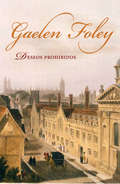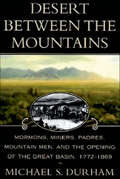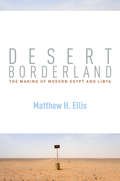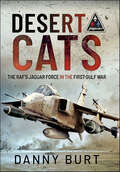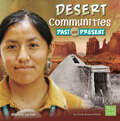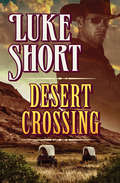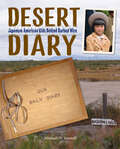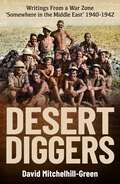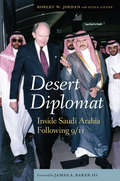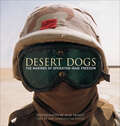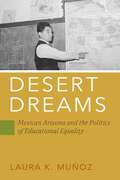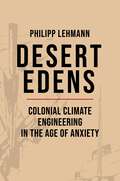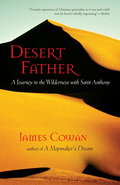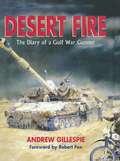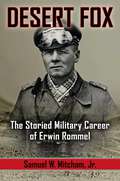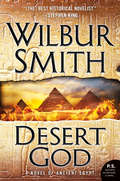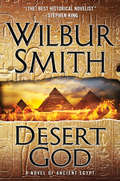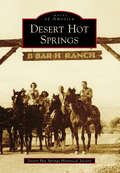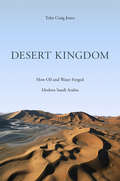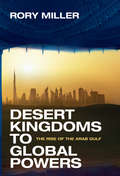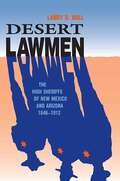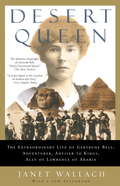- Table View
- List View
Deseos prohibidos (Saga de los Knight #Volumen 4)
by Gaelen FoleyUna sensual historia de amor y deseos prohibidos en la Inglaterra de principios del XIX. Cuarta entrega de la Saga de los Knight. Pocos conocen su verdadero nombre y origen. Para todos es Billy Blade, el jefe de una banda de ladrones que opera en los bajos fondos de Londres. Esta noche ha encontrado en su territorio a una joven de la aristocracia que se niega a decirle quién es, y solo le pide que la ayude a fugarse a París. Tal vez lo haga; él sabe lo que es huir de un pasado doloroso# De naturaleza apasionada y rebelde, lady Jacinda Knight ha decidido desafiar a todos con su escapada. No dejará que su hermano Robert imponga su voluntad obligándola a casarse sin amor. Y por fin dará un motivo del que hablar a quienes han esperado, desde siempre, que Jacinda repita los escándalos que protagonizó su madre. Una vez más, Gaelen Foley recrea con maestría la época de la Regencia, desde los oscuros y peligrosos callejones de los barrios bajos hasta los resplandecientes salones de baile de la alta sociedad, en una espléndida historia de amor y deseos prohibidos.
Desert Between the Mountains: Mormons, Miners, Padres, Mountain Men, and the Opening of the Great Basin, 1772–1869
by Michael S. DurhamOn July 24, 1847, a band of Mormon pioneers descended into the Salt Lake Valley. Having crossed the Great Plains and hauled their wagons over the Rocky Mountains, they believed that their long search for a permanent home had finally come to an end. The valley was an arid and inhospitable place, but to them it was Zion.They settled on the edge of an immense, uncharted, and self-contained region covering over 220,000 square miles, or one-fifteenth of the area of the United States. The early-nineteenth-century explorer John Charles Fremont had just aptly named this region the Great Basin because its lakes and rivers have no outlet to the sea: its waters course down the mountains and disappear into the desert. Here, in a land that few others wanted, the Mormons hoped to live and worship in peace. Within ten years of their arrival, the Mormons had established nineteen communities, extending all the way to San Diego, California--a remarkable feat of colonization and one of the great successes of the westward movement. Desert Between the Mountains is by no means, however, a story of splendid and stoic isolation. Beginning with an explanation of the Great Basin's unique and enigmatic topography, Michael S. Durham delineates the region as a crucible for a complex and exciting narrative history. Tales of nomadic Indian tribes, Spanish ecclesiastics, intrepid furtrappers, and adventurous early explorers are brilliantly and thoroughly chronicled. Moreover, Durham depicts the Mormon way of life under the constant strain from its interaction with miners, soldiers, mountain men, the Pony Express, railroad builders, federal officials, and an assortment of other so-called Gentiles. Durham vigorously explores the dynamics of this important chapter of American history, capturing its epic sweep, its near biblical mayhem, and its unforgettable characters in an illuminating and provocative account. Desert Between the Mountains concludes with the joining of the transcontinental railroad at Promontory, Utah, in 1869, an event that marked the end of the pioneer era. This is a dramatic, multifaceted, and definitive study of the Great Basin, demonstrating, for the first time, that it is a region unified in its history as well as its geography--that today includes all of Nevada, most of Utah, and parts of five other surrounding states.
Desert Borderland: The Making of Modern Egypt and Libya
by Matthew H. EllisDesert Borderland investigates the historical processes that transformed political identity in the easternmost reaches of the Sahara Desert in the half century before World War I. Adopting a view from the margins—illuminating the little-known history of the Egyptian–Libyan borderland—the book challenges prevailing notions of how Egypt and Libya were constituted as modern territorial nation-states. Matthew H. Ellis draws on a wide array of archival sources to reconstruct the multiple layers and meanings of territoriality in this desert borderland. Throughout the decades, a heightened awareness of the existence of distinctive Egyptian and Ottoman Libyan territorial spheres began to develop despite any clear-cut boundary markers or cartographic evidence. National territoriality was not simply imposed on Egypt's western—or Ottoman Libya's eastern—domains by centralizing state power. Rather, it developed only through a complex and multilayered process of negotiation with local groups motivated by their own local conceptions of space, sovereignty, and political belonging. By the early twentieth century, distinctive "Egyptian" and "Libyan" territorial domains emerged—what would ultimately become the modern nation-states of Egypt and Libya.
Desert Cats: The RAF's Jaguar Force in the First Gulf War
by Danny BurtOn 2 August 1990, Saddam Hussein’s armed forces invaded and occupied Kuwait. A swift international response followed, which, led by the United States and the United Kingdom, saw the formation of a coalition that formed the largest military alliance seen since the end of the Second World War. Among the many RAF units deployed under Operation Granby, the codename given to the British military operations during the conflict, was 41 Squadron, with elements taken from 54 Squadron and 226 OCU, which was equipped with the ubiquitous Jaguar GR1 single-seat all-weather tactical strike and ground-attack fighter. In late 1990, the squadron duly despatched a total of twelve aircraft, which soon became known for their distinctive desert pink camouflage, and twenty-two pilots from their base at RAF Coltishall. Initially conducting low-level strikes, for which the Jaguar Force had always been intended, over the weeks that followed 41 Squadron switched to more unusual medium-level missions. In total, the men and machines of 41 Squadron conducted a total of 617 sorties during Operation Granby. To complete this remarkable description of 41 Squadron’s part in the liberation of Kuwait, the author has interviewed a number of these pilots. As well as these veterans’ personal reflections, Danny Burt also explores the Jaguars’ record on air-to-ground combat and its performance in theatre, the various upgrades the type receive, and the unique nose art that each aircraft carried. Many of the pictures in this highly illustrated publication have never been published before. The story is completed by the recovery by the author of one of the Jaguar GR1s flown in the Gulf WarRescued from an Army range in South Wales, the aircraft was moved to RAF Coningsby where its restoration, including the return of its Operation Granby camouflage, is underway.
Desert Communities Past and Present (Who Lived Here?)
by Cindy Jenson-ElliottThe Cahuilla Indians have lived in the hot, dry desert for thousands of years. Learn how they have survived and thrived in this harsh environment and how their lives have changed and remained the same as the world has changed around them.
Desert Crossing
by Luke ShortA freight captain races across the desert to protect priceless cargo in this rollicking adventure from a master storyteller of the West. The guns come down the Colorado River, cases of army rifles that could mean life or death for the soldiers fighting the Indian Wars throughout the American West, and Dave Harmon is waiting for them. A grizzled, one-eyed freight captain, Harmon knows better than anyone how to drive cargo over the broad, merciless desert. The rifles could attract Apache, bandits, or worse, but none of that frightens him. The real trouble is one of the passengers: a major&’s beautiful daughter he&’s not sure he can trust. Soon Harmon is fighting off not only ruthless outlaws and Apache determined to defend their land, but backstabbing members of his own wagon train. In order to reach Fort Whipple with the guns and the girl, he&’ll have to take on his enemies singlehandedly—and destroy them all. Desert Crossing is a thrilling chase story featuring vibrant characters and rich, authentic western atmosphere from legendary author Luke Short.
Desert Diary: Japanese American Kids Behind Barbed Wire
by Michael O. TunnellA moving primary source sheds light on the experience of Japanese American children imprisoned in a World War II internment camp.A classroom diary created by Japanese American children paints a vivid picture of daily life in a so-called "internment camp." Mae Yanagi was eight years old when she started school at Topaz Camp in Utah. She and her third-grade classmates began keeping an illustrated diary, full of details about schoolwork, sports, pets, holidays, and health--as experienced from behind barbed wire. Diary pages, archival photographs, and narrative nonfiction text convey the harsh changes experienced by the children, as well as their remarkable resilience.
Desert Diggers: Writings From a War Zone 'Somewhere in the Middle East' 1940-1942
by David Mitchelhill-GreenDesert Diggers: Writings from a War Zone &‘Somewhere in the Middle East&’ 1940-1942 draws upon hundreds of soldiers&’ letters in a fresh and captivating narrative of the war in North Africa. Desert Diggers follows the first men to volunteer after the outbreak of war in 1939, tracing their adventures in exotic ports before further training in Palestine. A hunger for action grew: &‘Most of the chaps are ... anxious to get into anything that looks like a fight&’, one soldier wrote to his brother. From Egypt, &‘the hottest and dustiest place on God's earth&’ was the Diggers&’ next destination and their &‘blooding&’ in the battles for Bardia and Tobruk. After Rommel failed to storm Tobruk in April-May 1941, Nazi propaganda denigrated the garrison, &‘caught like rats in a trap&’. Amid frequent bombing and shelling, Berlin&’s scornful broadcasts were an unintended tonic. &‘Frequently we laughed and joked until the tears came into our eyes&’, a Digger quipped. From Tobruk, to the blunting of Rommel&’s attacks at El Alamein, the price of victory was palpably high: &‘some of my best mates didn't come out of it&’, lamented a corporal to his sister. Returning to Australia in 1943, some men maimed or traumatised, brought a further test for the Diggers ...Told in the words of the men who served, Desert Diggers offers a new personal perspective on the Western Desert campaign. With immediacy and raw emotion, these skillfully woven letters provide a remarkable and compelling account of the Australian experience of war.
Desert Diplomat: Inside Saudi Arabia Following 9/11
by Steve Fiffer Robert W. Jordan James A Baker IIIIn the spring of 2001, George W. Bush selected Dallas attorney Robert W. Jordan as the ambassador to Saudi Arabia. Jordan’s nomination sped through Congress in the wake of the terrorist attacks on 9/11, and he was at his post by early October, though with no prior diplomatic experience, as Saudi Arabia mandates that the U.S. Ambassador be a political appointee with the ear of the president. Hence Jordan had to learn on the job how to run an embassy, deal with a foreign culture, and protect U.S. interests, all following the most significant terrorist attacks on the United States in history.From 2001 through 2003, Jordan worked closely with Crown Prince Abdullah and other Saudi leaders on sensitive issues of terrorism and human rights, all the while trying to maintain a positive relationship to ensure their cooperation with the war in Afghanistan and the invasion of Iraq. At the same time he worked with top officials in Washington, including President Bush, Dick Cheney, Colin Powell, Donald Rumsfeld, Condoleezza Rice, George Tenet, and Tommy Franks. Desert Diplomat discusses these relationships as well as the historic decisions of Jordan’s tenure and provides a candid and thoughtful assessment of the sometimes distressing dysfunction in the conduct of American foreign policy, warfare, and intelligence gathering. Still involved in the Middle East, Jordan also offers important insights into the political, economic, and social changes occurring in this critical region, particularly Saudi Arabia.
Desert Dogs: The Marines of Operation Iraqi Freedom
by Amy Goodpaster Strebe Russ BryantA photographic account that highlights the human side of war, the day-in-the-life of US Marines stationed in Iraq.Desert Dogs includes dramatic, harrowing, and simply unbelievable images of the marines of Operation Iraqi Freedom, personal letters, and stories of coping with the pain of separation from their families and the horrors of war. Russ Bryant’s photography chronicles every aspect of the daily lives of these marines: lazy camels amble by a cargo drop; blinding sandstorms threaten to blow away tents, supplies, and marines alike; Scud missile attack sirens send marines scuttling to their bunkers; sniper fire crisscrosses marine convoys moving into Iraq; tanks and bombs topple the portraits of Saddam that seem to loom over every Iraqi village; shelled-out tanks, armored vehicles, and even busses litter the road on the way to Baghdad; medical personnel attend to fallen marines and prisoners alike; the occasional silent interlude allows time for prayer and remembrance.
Desert Dreams
by Deborah CoxAnne Cameron's delicate features and poised manner belied her upbringing as a riverboat gambler's daughter. Her papa was now dead and she was alone, except for the strong, handsome stranger who mysteriously rescued her from several unsavory gunfighters. But what Anne saw in Rafe Montalvo's black, piercing eyes made her shudder with apprehension -and desire. A DANGEROUS BOUNTY HUNTER Rafe Montalvo, a renowned vigilante, needed Anne to draw out the real target of his vengeance-the man who had destroyed his life and left him for dead in the desert. But while traveling countless miles through unforgiving desert, Rafe discovered that his need for Anne went deeper than revenge and became a thirst that could only be sated by love's sweet passion.
Desert Dreams: Mexican Arizona and the Politics of Educational Equality (Politics and Culture in Modern America)
by Laura K. MuñozMexican Arizona and the Politics of Educational Equality
Desert Edens: Colonial Climate Engineering in the Age of Anxiety (Histories of Economic Life #9)
by Philipp LehmannHow technological advances and colonial fears inspired utopian geoengineering projects during the late nineteenth and early twentieth centuries From the 1870s to the mid-twentieth century, European explorers, climatologists, colonial officials, and planners were avidly interested in large-scale projects that might actively alter the climate. Uncovering this history, Desert Edens looks at how arid environments and an increasing anxiety about climate in the colonial world shaped this upsurge in ideas about climate engineering. From notions about the transformation of deserts into forests to Nazi plans to influence the climates of war-torn areas, Philipp Lehmann puts the early climate change debate in its environmental, intellectual, and political context, and considers the ways this legacy reverberates in the present climate crisis.Lehmann examines some of the most ambitious climate-engineering projects to emerge in the late nineteenth and early twentieth centuries. Confronted with the Sahara in the 1870s, the French developed concepts for a flooding project that would lead to the creation of a man-made Sahara Sea. In the 1920s, German architect Herman Sörgel proposed damming the Mediterranean in order to geoengineer an Afro-European continent called &“Atlantropa,&” which would fit the needs of European settlers. Nazi designs were formulated to counteract the desertification of Eastern Europe and Central Asia. Despite ideological and technical differences, these projects all incorporated and developed climate change theories and vocabulary. They also combined expressions of an extreme environmental pessimism with a powerful technological optimism that continue to shape the contemporary moment.Focusing on the intellectual roots, intended effects, and impact of early measures to modify the climate, Desert Edens investigates how the technological imagination can be inspired by pressing fears about the environment and civilization.
Desert Exile: The Uprooting of a Japanese-American Family
by Yoshiko UchidaDesert Exile chronicles the experiences of a well-to-do Japanese American family before and during the internment of Japanese-Americans during the Second World War.
Desert Father: A Journey in the Wilderness with Saint Anthony
by James CowanThe spiritual exploits of Saint Anthony the Great--the prototype of the Christian "Desert Father"--have been immortalized in stories and art since the fourth century. Here is the stunning account of a modern seeker's quest to get beneath the legends that surround Anthony and to determine whether his extreme way of life has something to offer people in today's world. James Cowan's quest takes him to Egypt, to the monastery that still exists near the site of Anthony's hermitage, where he meets the monk who becomes his guide and mentor on the journey.He comes to regard Anthony and the colorful men and women who shared his lifestyle in the fourth through seventh centuries with affection and awe--their departure to the desert a flight from the status quo of the newly Christian empire in order to preserve the radical path to liberation they saw in Christian teaching. Our modern efforts toward liberation may look different from theirs, he concludes, but the ultimate goal is no different, and Anthony remains a luminous model for anyone who passionately seeks to know God.
Desert Fire: The Diary of a Cold War Gunner
by Andrew GillespieForming part of the Royal Artillery's historical series, Desert Fire is the Battery Commander of O Battery (The Rockett Troop), 2nd Field Regiment RA's gripping description of the Gulf War. His first-hand account brings to life the power and destructive force of modern massed artillery and is a fitting tribute to all members of the Royal Regiment who played such a vital role in the desert campaign. Shows detailed plans and maps of events first time around in the Gulf.
Desert Fox: The Storied Military Career of Erwin Rommel (Stackpole Military History Ser.)
by Samuel W. MitchamJust who was Erwin Rommel? War hero or war criminal? Hitler flunky or man of integrity? Military genius or just lucky? Now, bestselling military historian Samuel W. Mitcham Jr. gets to the heart of the mysterious figure respected and even admired by the people of the Allied nations he fought against. Mitcham recounts Rommel’s improbable and meteoric military career, his epic battles in North Africa, and his fraught relationship with Hitler and the Nazi Party. Desert Fox: The Storied Military Career of Erwin Rommel reveals: • How Rommel’s victories in North Africa were sabotaged by Hitler’s incompetent interference • How Rommel burned orders telling him to commit war crimes • Why it wouldn’t have helped Patton if he really had read Rommel’s book • How Rommel was responsible for the Germans’ defense against the D-Day landing • Why the plot to overthrow Hitler was fatally compromised when Rommel was gravely injured in an Allied attack • The reason Rommel agreed to commit suicide after his part in the plot was discovered by Hitler Mitcham’s gripping account of Rommel’s life takes you through the amazing adventure of the World War II battles in North Africa. Again and again, Rommel outfoxed the Allies—until the war of attrition and Hitler’s blunders doomed the Axis cause. Illustrated with dozens of historical photos, this illuminating biography paints a fascinating and tragic picture of the man known as the Desert Fox.
Desert God
by Wilbur SmithThe #1 International BestsellerGame of Thrones meets ancient Egypt in this magnificent epic from one of the world's biggest-selling authors. Conjuring the magic, mystery and bloody intrigue of a fascinating lost world, Desert God presents Wilbur Smith at the helm of one of the greatest stories of all time.On the gleaming banks of the Nile, the brilliant Taita--a freed slave and advisor to the Pharaoh--devises a plan to destroy Egypt's most feared enemy, the mighty Hyksos. His quest will take him on an epic journey up the ancient river, through Arabia and the magical city of Babylon and across the open seas--all in the company of the Pharaoh's exquisite sisters. With the future of the kingdom itself on his shoulders, Taita plunges into a world where the line between loyalty and betrayal shifts like the desert sands, evil waits in the shadows and death lingers on the edge of darkness.Hundreds of millions have fallen in love with the magic of Wilbur Smith. In Desert God, he is at the peak of his powers, transporting readers to an extraordinary time and place. This is a novel of supreme adventure, blazing action, heart-racing romance and a sense of history so real that you will feel the dunes moving beneath you and the Nile lapping at your feet.
Desert God: A Novel of Ancient Egypt
by Wilbur SmithEx-slave. Philosopher. Chosen one. Taita has risen from nothing to become the most trusted man at the Pharaohâe(tm)s side. Only he can plot a mission that will return Egypt to its former glory. Only he can muster the force that can break the back of Egyptâe(tm)s greatest enemy. Across the lush plains of Egypt, Taita, the eunuch slave whose freedom is long since won, now stands as a unique advisor to the Pharaoh. He is confidant, strategist poet and a father figure to the Pharaohâe(tm)s teenage sisters, Tehuti and Bekatha. Southern Egypt has an enemy it cannot shake for too long: they have been fighting the Hyksos people in the north since time began. And to finally crush them the Pharaoh must turn to his most trusted friend. Taita has an ingenious plan that will see Egypt destroy the Hyksos army and form the coveted alliance with Crete. This plan will take him, his expedition commander Zaras, and a team of warriors on an epic journey up the Nile, through Arabia to Sidon and the magical city of Babylon, and across the open seas to Crete. They will meet battle and betrayal on their journey but Taita must also contend with his charges, the spirited young princesses, Tehuti and Bekatha, whose respective love for warriors Zaras and Hui, threaten Taitaâe(tm)s plan to use them as offerings in his alliance with Crete, and the future of Egypt itself. Wilbur Smith is a master at the helm of one of the greatest stories of all time.
Desert Hot Springs
by Desert Hot Springs Historical SocietyCabot Yerxa's discovery of natural hot and cold mineral water in 1914 was the impetus for the establishment of Desert Hot Springs. His eccentric pueblo-style home, which is listed in the National Register of Historic Places, is a unique tourist attraction. L.W. Coffee also recognized the value of the hot water, so he drilled wells and opened his famous bathhouse in 1941. The development of more than 200 spas followed. Angel View Children's Hospital, established in the 1950s, uses the therapeutic water to treat disabled children. The city's extraordinary, pure cold water wins awards such as "best tasting in the world." Desert Hot Springs is the location of architect John Lautner's first desert commission, and Mary Pickford's house still stands at the famous B-Bar-H Ranch that was frequented by movie stars during the 1940s and 1950s. The historic Two Bunch Palms Resort and Spa is known as an exclusive celebrity hideaway. The city, believed to have an unusually strong vortex, is located just south of Joshua Tree National Park. An elevation of 1,200 feet affords most residents magnificent views of both Mount San Jacinto and Mount San Gorgonio.
Desert Kingdom: How Oil and Water Forged Modern Saudi Arabia
by Toby Craig JonesOil and water, and the science and technology used to harness them, have long been at the heart of political authority in Saudi Arabia. Oil’s abundance, and the fantastic wealth it generated, has been a keystone in the political primacy of the kingdom’s ruling family. The other bedrock element was water, whose importance was measured by its dearth. Over much of the twentieth century, it was through efforts to control and manage oil and water that the modern state of Saudi Arabia emerged. The central government’s power over water, space, and people expanded steadily over time, enabled by increasing oil revenues. The operations of the Arabian American Oil Company proved critical to expansion and to achieving power over the environment. Political authority in Saudi Arabia took shape through global networks of oil, science, and expertise. And, where oil and water were central to the forging of Saudi authoritarianism, they were also instrumental in shaping politics on the ground. Nowhere was the impact more profound than in the oil-rich Eastern Province, where the politics of oil and water led to a yearning for national belonging and to calls for revolution. Saudi Arabia is traditionally viewed through the lenses of Islam, tribe, and the economics of oil. Desert Kingdom now provides an alternative history of environmental power and the making of the modern Saudi state. It demonstrates how vital the exploitation of nature and the roles of science and global experts were to the consolidation of political authority in the desert.
Desert Kingdoms to Global Powers: The Rise of the Arab Gulf
by Rory MillerAn expert in Arab Gulf politics offers a revealing analysis of the region&’s stunning rise to global power and the challenges it confronts today. Once just sleepy desert sheikdoms, the Arab Gulf states of Saudi Arabia, Oman, the United Arab Emirates, Qatar, Bahrain, and Kuwait now exert unprecedented influence on international affairs—the result of their almost unimaginable riches in oil and gas. In this accessible study, Gulf politics expert Rory Miller examines the achievements of these countries since the 1973 global oil crisis. He also investigates how the shrewd Arab Gulf rulers who have overcome crisis after crisis meet the unpredictable future. The Arab Gulf region has become a global hub for travel, tourism, sports, culture, trade, and finance. But can the autocratic regimes maintain stability at home and influence abroad as they deal with the demands of social and democratic reform? Miller considers an array of factors—Islamism, terrorism, the Arab Spring, volatile oil prices, global power dynamics, and others—to assess the region&’s future possibilities.
Desert Lawmen: The High Sheriffs of New Mexico and Arizona Territories, 1846-1912
by Larry D. BallElected for two-year terms, frontier sheriffs were the principal peace-keepers in counties that were often larger than New England states. As officers of the court, they defended settlers and protected their property from the ever-present violence on the frontier. Their duties ranged from tracking down stagecoach robbers and serving court warrants to locking up drunks and quelling domestic disputes.The reality of their job embraced such mandane duties as being jail keepers, tax collectors, quarantine inspectors, court-appointed executioners, and dogcatchers.
Desert Prince
by Constance O'BanyonEgypt had finally fallen under the mighty fist of Rome. Queen Cleopatra lay entombed in the arms of her lover, and a false emperor ascended to the throne.... Young Julian Tausrat, Prince of the Badari and blood kin to the late Queen, was forced to flee Egypt. On the island of Bal Forea, he trained in the ways of the warrior and waited for the day when he could return to claim the desert land that was his birthright and the girl who had refused to betray him. The Sabinah he found was no longer the child who had shadowed his footsteps, nor the slender young woman whose untutored kisses had awakened his own desire. This Sabinah held a secret that could free Egypt from Roman tyranny...or sentence Julian and his people to death. Only by trusting in her courage and his own strength could the Desert Prince save both the people he was destined to rule and the woman he was fated to love.
Desert Queen: The Extraordinary Life Of Gertrude Bell: Adventurer, Adviser To Kings, Ally Of Lawrence Of Arabia
by Janet WallachTurning her back on her privileged life in Victorian England, Gertrude Bell (1868-1926), fired by her innate curiosity, journeyed the world and became fascinated with all things Arab. Traveling the length and breadth of the Arab region, armed with a love for its language and its people, she not only produced several enormously popular books based on her experiences but became instrumental to the British foreign office. When World War I erupted, and the British needed the loyalty of the Arab leaders, it was Gertrude Bell's work and connections that helped provided the brain for T. E. Lawrence's military brawn. After the war she participated in both the Paris and Cairo conferences, played a major role in creating the modern Middle East, and was generally considered the most powerful woman in the British Empire. In this incident-packed biography, Janet Wallach reveals a woman whose achievements and independent spirit were especially remarkable for her times, and who brought the same passion and intensity to her explorations as she did to her rich romantic life. Too long eclipsed by Lawrence's fame, Gertrude Bell emerges in this first major biography as a woman whose accomplishments rank as crucial to world history (especially in light of the continuing geopolitical importance of the Middle East) and whose life was a grand adventure.
